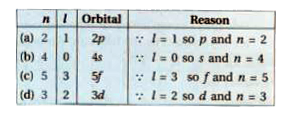Using s,p,d f notations describe the orbital with the following quantum number
(a)n=2,l=1(b)n=4,l=0
(c ) n=5,l =3 (d ) n=3 , l= 2 Solution in Gujrati
Topper's Solved these Questions
- STRUCTURE OF ATOMBOOK - KUMAR PRAKASHANCHAPTER - STRUCTURE OF ATOMEXERCISE - Section -A (Try Your Self -1)
4 Videos
- STRUCTURE OF ATOMBOOK - KUMAR PRAKASHANCHAPTER - STRUCTURE OF ATOMEXERCISE - Section -A (Try Your Self -2)
5 Videos
- STATES OF MATTER BOOK - KUMAR PRAKASHANCHAPTER - STATES OF MATTER EXERCISE - QUESTION PAPER FROM MODULE (SECTION - A)
4 Videos
- THE P-BLOCK ELEMENTSBOOK - KUMAR PRAKASHANCHAPTER - THE P-BLOCK ELEMENTSEXERCISE - SECTION-D NCERT EXEMPLAR SOLUTION (MCQs) LONG ANSWER
25 Videos
Similar Questions
Find neutron electron and proton in the following

View SolutionCalculate the number of electron in one mole N−3 ion.
View SolutionGiven Dalton.s Law of partial Pressure, its mathematical formula and explain aqueous tension.
View SolutionDescribe the general trends in the following properties of the elements in Groups-13
Atomic size
View Solutionusing s, p, d notations describe the orbital with the following quantum numbers .
(a) n = 2 l=1, (b) n = 4 , l = 0, (c) n= 5 , l=3 , (d) n = 3 , l = 2
View Solutions, p, d,f संकेतन क प्रयोग करके निम्नलिखित क्वांटम संख्याओं वाले कक्षक के बारे में बताइए -.
(a) n = 2 l=1, (b) n = 4 , l = 0, (c) n= 5 , l=3 , (d) n = 3 , l = 2
View Solutions, p, d संकेतन द्वारा निम्नलिखित क्वांटम संख्या वाले कक्षको को बताइए-
(क) n=a,l=0
(ख) n=3,l=1
(ग) n=4,l=2
(घ) n=4,l=3
View SolutionUsings,p,d,f notations, describe the orbital with the following quantum numbers.
(i) n=2,l=1
(ii) n=4,l=0
9iii) n=5,l=3
(iv)n=3,l=2
View Solutions,p,d संकेतन द्वारा निम्नलिखित क्वांटम संख्याओं वाले कक्षकों को बताइए -
(क) n=1,l =0 (ख)n=3,l=1
(ग) n=4,l=2 (घ) n=4,l=3
View Solutions, p, d, f का प्रयोग करते हुए निम्नलिखित क्वांटम संख्याओं युक्त ओर्बिटलों को परिभाषित कीजिए।
(a) n=2, l=0 (b)n=3, l=1 (c ) n=1, l=0 (d) n=4, l=2 (e ) n=5, l=3
View SolutionUsing the s,p,d notations, describe the orbital with the following quantum numbers :
(a)n=1,l=0 (b)n=3,l=2
(c)n=3,l=1 (d)n=2,l=1
(e)n=4,l=3 (f)n=4,l=2.
View SolutionUsing s, p, d, f notations, describe the orbital with the following quantum numbers (a) n=2, l = 1 (b) n = 4, l = 0 (c) n = 5, l = 3 (d) n = 3, l = 2.
View SolutionUsing the s, p, d, notation, describe the orbital with the following quantum numbers? (a) n = 1, l=0, (b) n = 2,l = 0, (c) n = 3, l = 1, (d) n = 4, l =3.
View SolutionUsing s, p, d, f notations, describe the orbital with the following quantum numbers (a) n=2, l = 1 (b) n = 4, l = 0 (c) n = 5, l = 3 (d) n = 3, l = 2.
View SolutionUsing the s, p, d, notation, describe the orbital with the following quantum numbers? (a) n = 1, l=0, (b) n = 2,l = 0, (c) n = 3, l = 1, (d) n = 4, l =3.
View SolutionUsing s, p, d, f notations, describe the orbital with the following quantum numbers (a) n=2, l = 1 (b) n = 4, l = 0 (c) n = 5, l = 3 (d) n = 3, l = 2.
View Solution

